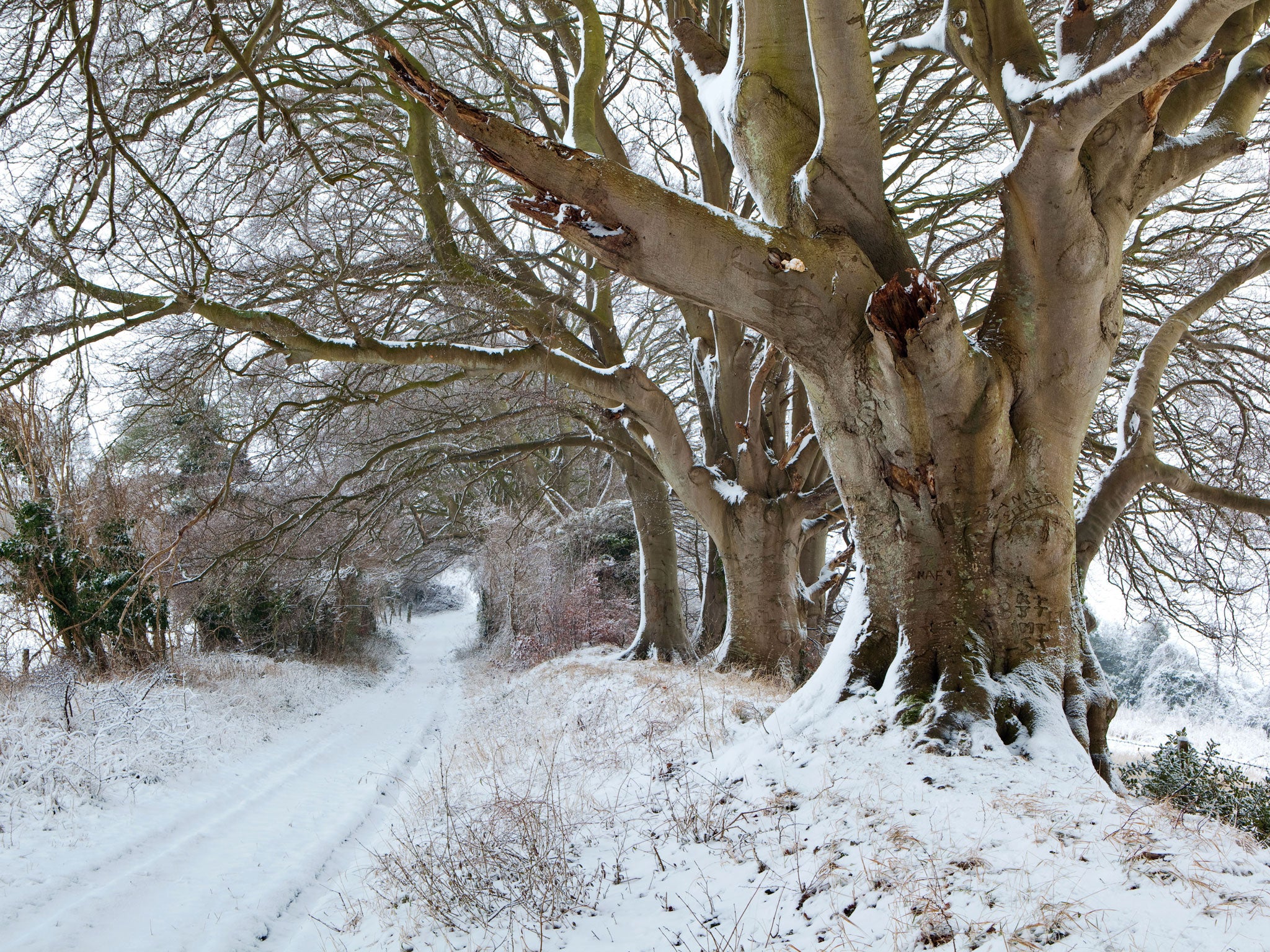Anna Pavord: 'Admire the bark of a beech tree in winter'
Take a winter walk in the Chilterns in Buckinghamshire, or head for Hampshire, the South Downs in Sussex, or the Cotswolds in Gloucestershire, says our gardening correspondent

Trees in the winter landscape are even more telling than they are in summer. Bare, in silhouette against the sky, they become ready-made etchings or woodcuts. No wonder our best artists drew them so often. In summer, for instance, beech trees present a big mound of green. The outline is still recognisable, but the detail is masked by the mass. And yes, they are spectacular in autumn as paint dabs of foxy-brown drift down from the trees to carpet the ground underneath.
But look at the beech trees now: wide spreading crowns, beautifully balanced – as long as they have room to do the necessary spreading. The intricate lines at the centre taper out to the finest imaginable brush strokes of twig at the extremities. They are more elaborately branched than other big native trees. No other tree has such shapely, elegant buds, tight-wrapped now during winter.
Here in our valley is not their place. This is a landscape of oak and thorn. Though there are splendid outliers all round here, beech tends to favour chalk. The Chilterns are famous for their hanging woods of beech. The chalk escarpment that sustains them there stretches right across the country, ending here in Dorset on the Cranborne Chase. On these dryish, free-draining soils beech live for hundreds of years, even longer if they are pollarded. They often were, for the wood makes the best firewood. Pollarding, rather than felling, ensured the supply was sustainable.
So to admire beech, take a winter walk (the best way to spend a Boxing Day) in the Chilterns in Buckinghamshire, or head for Hampshire, the South Downs in Sussex, or the Cotswolds in Gloucestershire. These are natural beech strongholds, though they have adapted superbly well to various sites in Scotland: the Earl of Fife planted so many in Morayshire that he was awarded a medal by the Society of Arts for his efforts. There are some champion trees there, including a splendid one, with a girth of nearly 6m, south of Tomich in the north-west Highlands. Check them out at the woodlandtrust.org.uk.
Last year Brighton dendrologist Peter Bourne reported an outstandingly tall beech growing in the National Trust's Newtimber Holt on the escarpment of the South Downs, near Hurstpierpoint in Sussex. Tree climbers scaled it this April and confirmed that it was 44m high, which makes it the tallest native tree to have been measured in Britain. The beech is well situated on a sheltered slope, which has obviously helped it to flourish. You can see it from a public footpath which runs through the woodland just above it.
In winter, you are in a better position to admire the bark of a beech tree – smooth, silky silver, quite unlike the bark of other trees. It doesn't furrow or crinkle. You can put your cheek against it and it is as hospitable and comforting as an old linen pillowcase. But the trees suffered terribly in the drought summer of 1976. We had two superb old beech in the garden at our old house. One of them was unable to struggle through those awful months and we had to fell it.
The effects of the drought were still showing themselves years later, as the weakened trees succumbed either to disease orstrong winds. The magnificent beech at Tullynally in Ireland, one of the stars of Thomas Pakenham's book Meetings with Remarkable Trees, blew down in a storm on Boxing Day 1999. Splayed out on the ground, each of its five main limbs had the girth of a fair-sized trunk. "I haven't the heart to cut it up for firewood," wrote Pakenham. "I feel its loss like a sort of bereavement."
Garden-makers, such as Henry Hoare, who in 1741, first started to lay out the magnificent landscape garden at Stourhead in Wiltshire, tended to choose selected versions of the native beech for their plantings – beech with especially feathery leaves such as Fagus sylvatica 'Aspleniifolia' or purple foliage (F. sylvatica Atropurpurea Group). Stourhead, now owned by the National Trust, is a wonderful place to see trees in their winter glory. They have both native and fern-leaved beech there, but in winter the distinction between the two disappears. The silhouette is all.
The staggering beauty of this private world, enclosed by hills and woods, is all the more poignant because it was born out of grief. The creation of the Stourhead landscape became a kind of solace for Henry Hoare, who had suffered the loss, not only of his wife, but also his son and two of his daughters. Take a winter walk to see how brilliant a creation it is – the water, the woods and the classical buildings constantly changing in relation to each other. It is open daily (9am-5pm) Admission £8.50.
Join our commenting forum
Join thought-provoking conversations, follow other Independent readers and see their replies
Comments